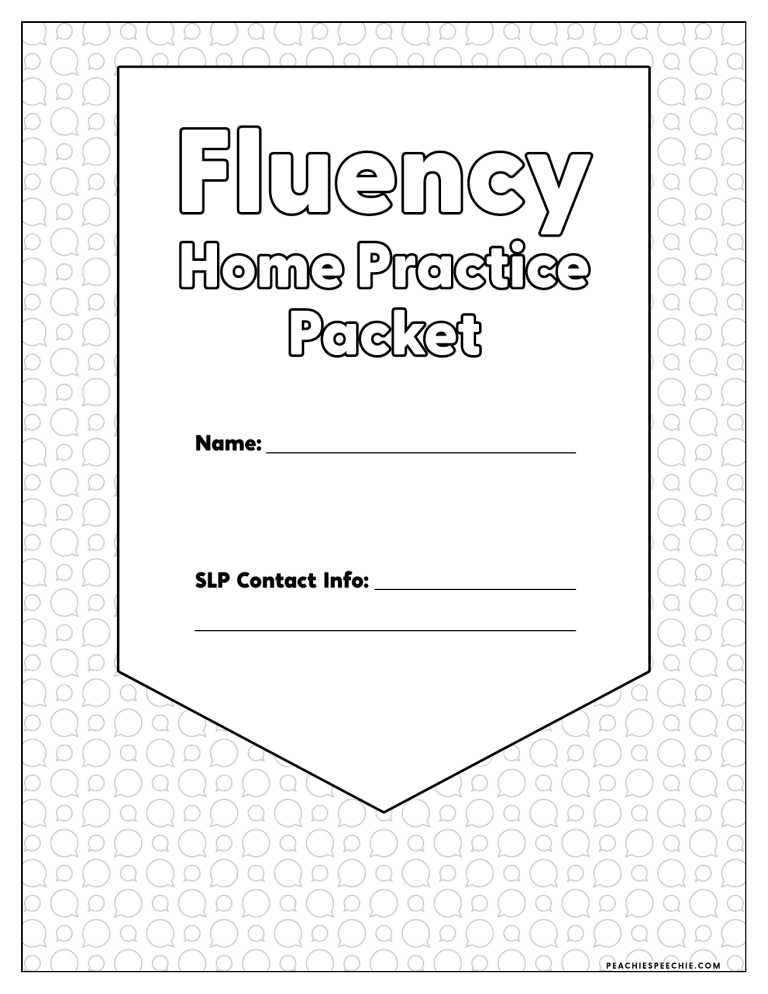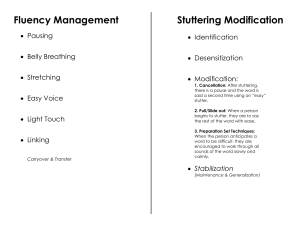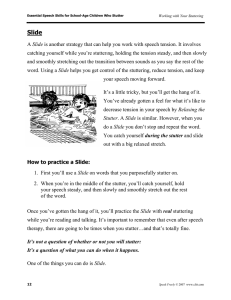
Name: SLP Contact Info: You have worked hard in speech therapy. Now it is time to practice at home! Some of these activities require a partner. Your partner can be anyone you choose! They can be a parent, friend, or sibling! Choose one activity every day. At the end of the week, have your partner sign the bottom of this page. Share Your Strategies Tell your partner about the different fluency strategies you have learned. Which ones do you like the most? Why? Learn About People Who Stutter Did you know that many famous and successful people stutter? Learn about one famous person who stutters and share what you learned with your partner. Draw It Out Draw a picture of what it is like to stutter. How does it make you feel? Optional activity: See pictures other children drew here: Positive Self Talk It’s OK to stutter! Color the attached picture and remind yourself of this. Write 6 positive things about yourself on the back of the sheet. What are you good at? What do you love about yourself? Read Out Loud Find your favorite book. Read it to your partner while you use your fluency strategies. If you are still learning to read, you can listen as your partner reads to you and then retell the story while using your strategies. Become A Teacher Teach someone all about something you love. You can teach them how to play a video game, how to make your favorite snack, how to fold a paper airplane or something else! The choice is yours. Use your fluency strategies as you talk. Pseudostuttering Pretend to stutter! As you pretend to stutter, practice your strategies to get out of the stutter (pull outs and cancellations). Ask your partner to do it with you! Anatomy Craft Do you know the parts of your “speech machine”? Complete the attached craft and label the body parts. Share your knowledge with your partner! Story Time Make up a story. You can write it down, or just make it up in your head. Tell your story to your partner. Use your fluency strategies. How did you feel about your speech? Partner signature: https://www.stutteringhelp.o rg/drawings-and-letters-kids Date: Fluency Strategies Commonly Taught In Speech Therapy* Fluency Shaping Strategies Changing the rate, breathing, or tension to help prevent a stutter. The focus here is fluency and doing what you can to increase fluent utterances. Easy Onset - starting your airflow prior to turning your voice on Slow Speech - reducing the rate of your speech Light Contact - very gently touch your articulators (tongue, lips, etc.) together as you speak Stretchy Speech - stretching out words, running them together Diaphragmatic Breathing + Relaxed Muscles - think about your muscles and relax your shoulders, lips, and neck before starting to speak. Take a deep breath instead of a shallow one and immediately start gentle phonation (don’t hold your breath!) Continuous Phonation - keeping your voice on (similar to singing) so speech is less choppy Pausing - speak in shorter phrases, pausing between the phrases Stuttering Modification Strategies Strategies for use in the moment of stuttering. They reduce tension and secondary behaviors during a stutter. These strategies help you get through the disfluent moment and continue speaking. Cancellation - pausing after a disfluency occurs, releasing tension, and starting again Pull-Outs (aka: Sliding Out) - releasing tension in the moment to slide out of a stutter Preparatory Set - when you feel a stutter coming on, ease into the word by prolonging the start of the word, using gentle contacts, and/or reducing rate Bouncing - gently bounce into a word instead of having tense repetitions Catching the Stutter - becoming aware of tension while you are speaking. Student may tighten their fist to increase awareness of tension in their lips/throat/neck. Video of this technique: http://speakfreelypublications.com/speak-freely-vi deo-catching-the-stutter/ *Ask your speech-language pathologist which strategies they have been teaching during therapy! Many SLPs teach a combination of fluency shaping and stuttering modification strategies to help their students. A Few Famous People Who Stutter Don’t let your stutter hold you back! Many famous and successful people stutter. Remember, it’s OK to stutter! Read about a few famous people who stutter below. Emily Blunt: An actress who has starred in movies including Mary Poppins, The Adjustment Bureau and others. She has won Golden Globe and Screen Actors Guild awards. She was born in London and struggled with stuttering as a child. She says that she still stutters some as an adult. She has been on the board of directors for the American Institute of Stuttering. Video of Emily Blunt speaking about her stutter: https://www.youtube.com/watch?v=qYrEEe1MdxE Joe Biden: Vice President of the United States from 2009-2017. He has said his stutter doesn’t define him, and has given many public speeches. He has shared that he keeps in touch with other people who stutter and still stutters sometimes as an adult. Video of Joe Biden speaking about his stutter: https://www.youtube.com/watch?v=iWn1CkIU_rc Darren Sproles: National Football League (NFL) star. He played in college at Kansas State and then for the San Diego Chargers and New Orleans Saints. He has said that it was hard for him to speak during interviews due to his stutter, but he worked with a speech-language pathologist to learn strategies and help him speak more confidently. Article about Darren Sproles and stuttering: https://www.stutteringhelp.org/famous-people/darren-sproles Carly Simon: As a child, Carly was shy and frequently made fun of by other children. She grew up to win an Oscar and a Grammy award. She is a famous singer, musician, and children’s book author. She is also a breast cancer survivor. Video of Carly speaking about her stuttering: https://www.youtube.com/watch?v=2H19zu2J9Is Speech Anatomy brain vocal folds lungs lips, teeth, and tongue trachea diaphragm Speech Anatomy Parts Cut out the speech anatomy parts and labels below. Glue them where they belong on the speech anatomy character who’s missing his parts. lungs brain lips, teeth, and tongue vocal folds diaphragm trachea Speech Anatomy Cut & Paste Daily Data: Feelings About My Speech After completing your activity for the day, color in one face to show how you feel about your speech. Did you feel confident and happy? Nervous? Frustrated? You can write additional notes in the space provided if you choose to. Remember, it’s OK to stutter! Day 1 Date: Day 2 Date: Day 3 Date: Day 4 Date: Day 5 Date: Additional notes: Fluency Home Practice FAQ Thank you for downloading this packet from Peachie Speechie! We hope this product is helpful to you and your students. Before you dive into this fabulous new product, let’s chat about Terms of Use. We work hard to bring you creative, high quality products. We ask that you abide by our Terms of Use when enjoying them. Here are some frequently asked questions about our TOU. Please note, TOU for this product are more relaxed than usual to make sharing this easier during school closures due to COVID-19. Can I email this packet to parents to use at home with their children? YES! You can email this packet to parents of your students. Can I make multiple copies of this product for my students and their parents? YES! Absolutely! You can make as many copies as you need to use in your sessions with your students/clients. You can also make copies for their parents to use at home for homework. We are doing digital learning at my school. Can I share this product with my students online? Yes, you may share this packet on secure password protected platforms such as SeeSaw or Google Classroom. Please do not share on public sites or shared drives. If an SLP would like a copy of this packet, direct them to this link instead: www.peachiespeechie.com/homepractice All of the SLPs in my district want copies. Can I email it to my SLP friends? No. If other SLPs want copies, simply give them this link and they can download their own copy for FREE from my website. Please don’t email it to your SLP friends. We want them to check out our website and download it for free themselves! That way, they will have their own account and automatic access to updates if I edit or add to the product in the future. www.peachiespeechie.com/homepractice I have more questions or comments about your products. Who can I contact? We are happy to answer your questions. You can email Josh@peachiespeechie.com or Meredith@peachiespeechie.com and we will get right back to you. Thank you for being a Peachie Speechie customer. We appreciate you and can’t wait to create more products for you. Sincerely, Josh and Meredith Need more fluency materials? Click here!


